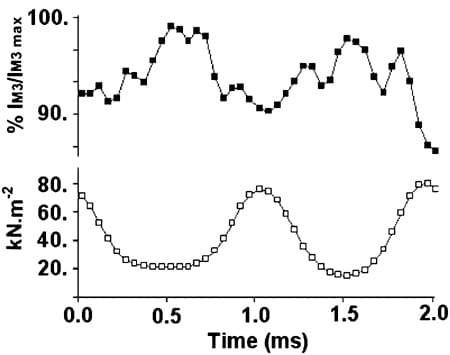Reduction of ionic strength promotes formation of ‘weakly binding’ cross-bridges in skeletal muscle, an actin-bound S1 state differing from rigor and Ca2+-activated states in that S1 is unloaded, and thought to be a pre-power stroke intermediate in the cross-bridge cycle.
We induced this state in fibre bundles from sartorius muscles of Rana temporaria (humanely killed by decapitation, fibre bundles skinned in 1 % Triton X-100 for 2-5 min) by reducing ionic strength in a relaxing solution from 130 mM (HIS) to 35 mM (LIS). Bundle stiffness increased from 6.9 ± 4.9 % to 13.8 ± 6.6 % (n = 12, means ± S.D.) of rigor stiffness without a rise in axial tension, consistent with the formation of low force cross-bridges.
X-ray diffraction patterns were obtained by exposure to synchrotron radiation (l = 0.15 nm, beam dimensions: 0.3 X 0.2 mm; A2 beamline, DESY, Hamburg). X-ray data were collected on a delay line linear detector or on image plates positioned 2.5 m from the preparation. The most significant effect of LIS was on the ratio of 11 to 10 equatorial intensities (I11/I10), which rose from 0.30 ± 0.30 (n = 49) to 0.69 ± 0.56 (n = 11). In rigor, I11/I10 was 2.80 ± 1.99 (n = 16). The LIS rise in I11/I10 occurred principally through an increase in I11; I10 remained almost unchanged (Xu et al. 1987).
In Ca2+-activated fibres, 1 kHz sinusoidal length oscillations produce a sinusoidal change in meridional M3 reflection intensity (IM3), maximum intensity (IM3,max) occurring at maximum shortening. In rigor, oscillations produce a sinusoidal IM3 signal, but with IM3,max at maximum lengthening (Dobbie et al. 1998). This shift in IM3,max may indicate a change in S1 lever arm orientation. We imposed oscillations in LIS, and observed an IM3 change having the same phase relation to the oscillations as observed in Ca2+-activated fibres (Fig.1). The intensity signal was 5-10 % of IM3,max, compared to a value of 20-30 % in Ca2+ activation. The lever arm disposition required to account for these findings is consistent with a pre-power stroke state S1 structure in LIS.
This work was supported by IHP-Contract HPRI-CT-1999-00040/2001-00140 of the E.U.

